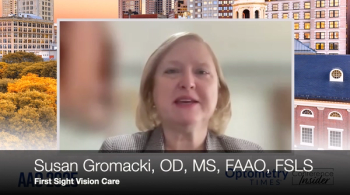
Diagnosing CHRPE lesions can be a challenge for ODs
A 26-year-old healthy ophthalmically asymptomatic female patient attended the University of Alabama School of Optometry clinic for a periodic ophthalmic evaluation. Her history was significant for myopic refractive correction, for which she wore soft contact lenses successfully.
A 26-year-old healthy ophthalmically asymptomatic female patient attended the University of
Alabama School of Optometry clinic for a periodic ophthalmic evaluation. Her history was significant for myopic refractive correction, for which she wore soft contact lenses successfully. The medical, family, and medication histories were non-contributory. The patient denied eye pain, discharge, double-vision, color perception abnormalities, redness, itch, and previous ocular surgery.
Exam findings
Visual acuity was correctable to 20/20 in each eye. The anterior segment and contact lens evaluations were unremarkable in each eye.
Her intraocular pressure measured 16 mm Hg OD and 17 mm Hg OS. Dilated fundus examination revealed a normal-appearing posterior pole in each eye and peripheral pigmented lesion in the superior temporal region of the right eye (see Figure 1).
The pigmented characteristics of the area remained visible with red-free light. There was no perception of elevation or cellular response associated with the lesion.
Previously from Dr. Semes:
On further questioning, the patient denied episodes of blurred vision and blunt ocular trauma. She was unable to recall any periods of significant ocular redness or treatment for infection.
Given the clinical findings, the differential diagnoses are not limitless. These diagnoses involve disturbance of the retinal pigment epithelium (RPE). Considerations include post-inflammatory/infectious, post-traumatic, and congenital (e.g., congenital hypertrophy of RPE [CHRPE]) entities.
Related:
In the absence of a history of trauma, the field narrows. Choroidal nevus emerges in the realm of pigmented fundus lesions but would be ruled out by the persistence of the pigmented lesion in its entirety when viewed with red-free light.
Whether the fundus appearance is due to CHRPE or a post-inflammatory scar, there is little that would alter observation about the clinical course. With the exception of a recurrence of a toxoplasmosis lesion, standard vigilance is appropriate with admonition regarding floaters and blurred vision, potentially indicative of reactivation. The patient was questioned specifically regarding the risk pool for toxoplasmosis exposure-all of which she denied.
Follow-up exam and diagnosis
The patient was seen at the same clinic five years later for follow-up. The history and physical findings were unchanged. The exception was the appearance of the peripheral lesion that was observed at the initial visit (see Figure 2).
With the depigmentation of the lesion evident, it became clear that the diagnosis is CHRPE. These lesions are generally round and demonstrate a halo of atrophy, hence the moniker “halo nevus” used incorrectly by some. Another distinct example of a solitary CHRPE lesion is shown in Figure 3.1
Related:
As the clinical descriptor suggests, these lesions are present at birth. Variations have been associated with familial adenomatous polyposis (FAP).2,3,4
Although controversy surrounds the connection, bilaterality and numerous small presentations (sometimes referred colloquially as “animal” or “bear tracks”) seem to be the most consistent indicator for a gastrointestinal consultation. Single lesions could be present among certain at-risk patients; such extra-colonic manifestations should be followed up.2,3
Histologically, geographic CHRPE lesions displace the overlying photoreceptor cells, resulting in a scotoma.5 The present case was not evaluated perimetrically because the lesion was well anterior of the equator. CHRPE lesions have been reported to change over time.
Central presentations may interfere with visual acuity.6-8 In the periphery, they may remain stable with the exception of depigmented appearance, as this case illustrates.
Related:
References
1. Shields CL, Mashayekhi A, Ho T, Cater J, Shields JA. Solitary congenital hypertrophy of the retinal pigment epithelium: clinical features and frequency of enlargement in 330 patients. Ophthalmology. 2003 Oct;110(10):1968-76.
2. Nusliha A, Dalpatadu U, Amarasinghe B, Chandrasinghe PC, Deen KI. Congenital hypertrophy of retinal pigment epithelium (CHRPE) in patients with familial adenomatous polyposis (FAP); a polyposis registry experience. BMC Res Notes. 2014 Oct;18(7):734.
3. Chen CS, Phillips KD, Grist S, Bennet G, Craig JE, Muecke JS, Suthers GK. Congenital hypertrophy of the retinal pigment epithelium (CHRPE) in familial colorectal cancer. Fam Cancer. 2006;5(4):397-404.
4. Parisi ML. Congenital hypertrophy of the retinal pigment epithelium serves as a clinical marker in a family with familial adenomatous polyposis. J Am Optom Assoc. 1995 Feb;66(2):106-12.
5. Tzu JH, Cavuoto KM, Villegas VM, Dubovy SR, Capo H. Optical Coherence Tomography Findings of Pigmented Fundus Lesions in Familial Adenomatous Polyposis. Ophthalmic Surg Lasers Imaging Retina. 2014 Jan-Feb;45(1):69-70.
6. Zucchiatti I, Battaglia Parodi M, Pala M, Bandello FM. Macular congenital hypertrophy of the retinal pigment epithelium: a case report. Eur J Ophthalmol. 2010 May-Jun;20(3):621-4.
7. Shields CL, Materin MA, Walker C, Marr BP, Shields JA. Photoreceptor loss overlying congenital hypertrophy of the retinal pigment epithelium by optical coherence tomography. Ophthalmology. 2006 Apr;113(4):661-5.
8. Nishikatsu H, Shiono T. Congenital hypertrophy of the retinal pigment epithelium in the macula. Ophthalmologica. 1996;210(2):126-8.
Newsletter
Want more insights like this? Subscribe to Optometry Times and get clinical pearls and practice tips delivered straight to your inbox.


















































.png)


